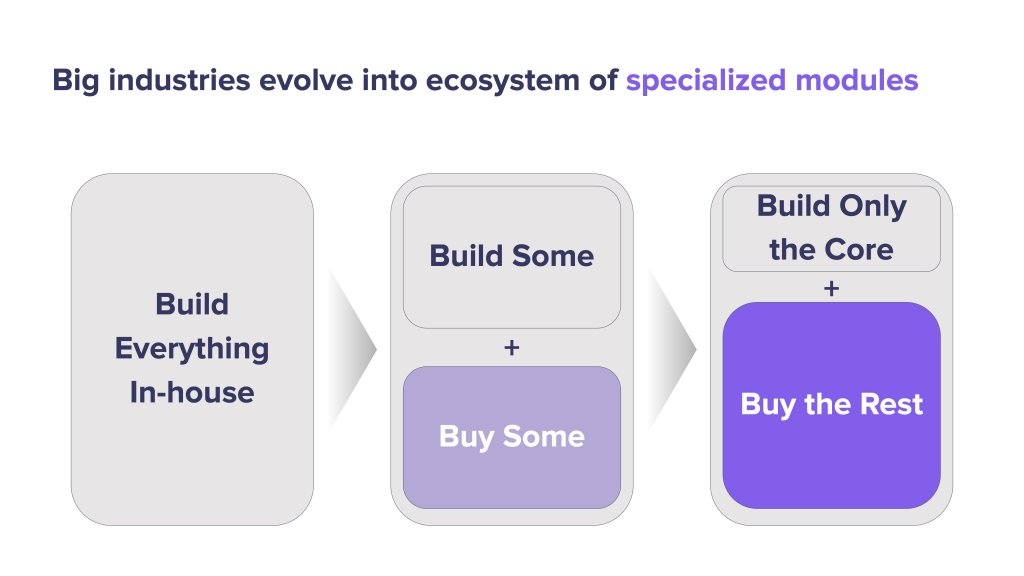One of the macro trends we’re seeing in the software industry today is the rise of the API economy. API (Application Programming Interface) allows implementation, operation, and maintenance to become simpler by providing a set of input rules to the developers outside of the API software and giving them functionalities and processed results in return.
As discussed in the management framework #2 — abstraction and reduction — API is analogous to hiring a good management layer in a company, to provide more leverage to the developer allowing productivity gain through an abstraction layer of software. This abstraction stage is a critical phase in any industry to grow exponentially, as in any complex-enough industry, building all of the value chain end-to-end becomes infeasible and the trade-off between control and speed/quality/resource gets exponentially larger.
So once an industry starts to get specialized in each part of the value chain, companies form partnerships to source ingredients, manufacture parts, assemble into solutions, and distribute to the end customers.

Software industry has been going through similar transition in the past few decades. The software world began where a group of engineers would build an entire software end-to-end. Early days of computer games and any meaningful software were built this way.
Then in the 90s to early 2000s, as softwares became more complex, the engineering also became more modular through the introduction of OOP (Object Oriented Programming), Some generalized parts of the software were built using open-source projects similar to using lego blocks, and specialized parts were built through a combination of internal engineering and outsourcing to devshops/SI partners.

Now in the later 2000s to 2010s, we began to see the rise of API and SDK companies. Visa’s recent $5.3B acquisition of Plaid shows how much value businesses are anticipating to be gained from these kind of “abstraction layers.” Okta (authentication) is valued $15B+, Stripe (payment) privately valued $35B+, Snowflake (data warehouse) privately valued $4B+, Twilio (SMS) valued $17B+, Braze (notification) privately valued ~$1B, SendBird (chat and messaging) and others just show how much this API industry has grown in the past ~10 years.
The primary reason for leveraging these kind of API software is for productivity gain for developers — to shorten the implementation time, accelerate go-to-market, gain quality and richness of the functionality, and save resources along the way. But the beneficial side-effect is the risk-mitigation for the businesses. By adopting API that’s more battle-tested allows the buyer to de-risk their business. Any mature API software will have experienced wide range of use cases, traffic patterns and volumes, edge cases, and even security incidents. This allows the new buyer to gain the productivity while de-risking their business significantly.

Then the risk becomes more simplified through abstraction — the sustainability and scalability of the API and its company is the risk of adoption. This is identical as all forms of business partnership. The financial viability and direction of a partner becomes more critical for risk management. So as an API company, or any partner, the leadership must focused on the alignment of value creation with the customers, and its financial sustainability.
Due to this evolutionary landscape, B2B enterprise softwares have evolved to adopt cloud infrastructure and operate based on recurring revenue subscriptions as their primary business models which are usually tied to volume (e.g. users, API calls, seats, etc.) that comes with relatively healthy gross margins. This allows companies to re-invest into products and their services, resulting in growing and massively scalable businesses that now have scaled to be individually valued in multiple billions of dollars, if not more.
So as a whole, this is a triumph to the software industry and its engineers, as the macro trend of API economy has provided exponential productivity gains and de-risking of the businesses, and I expect this trend to continue to proliferate throughout the rest of the software stacks.
What’s next? I anticipate that AI and Machine Learning will start to provide layers of abstraction for software generation from data, allowing again, exponential gains in productivity and de-risking for developers around the world.